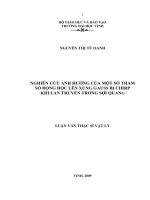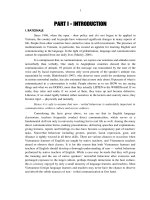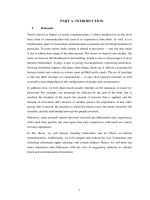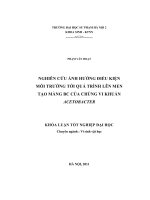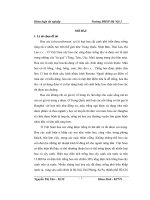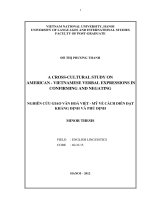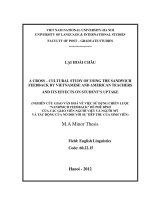a vietnamese - american cross-cultural study of encouraging = nghiên cứu giao văn hóa việt - mỹ về hành động khích lệ
Bạn đang xem bản rút gọn của tài liệu. Xem và tải ngay bản đầy đủ của tài liệu tại đây (1.19 MB, 116 trang )
iv
TABLE OF CONTENTS
CERTIFICATE OF ORIGINALITY OF PROJECT REPORT i
ACKNOWLEDGEMENTS ii
ABSTRACT iii
TABLE OF CONTENTS iv
LIST OF ABBREVIATIONS AND CONVENTIONS vii
LIST OF TABLES viii
LIST OF FIGURES ix
INTRODUCTION 1
1. Rationale 1
2. Aims of the study 1
3. Scope of the study 2
4. Methods of the study 2
5. Organisation of the study 3
DEVELOPMENT 4
Chapter 1: LITERATURE REVIEW 4
1.1. Pragmatics and cross-cultural pragmatics 4
1.2. Speech acts 5
1.2.1. Definition of speech acts 5
1.2.2. Classifications of speech acts 7
1.2.3. Encouraging as a speech act 9
1.2.4. Encouraging and comforting 10
v
1.3. Politeness in Cross-cultural pragmatics 10
1.3.1. Politeness defined 10
1.3.2. Conversational-maxim view on politeness 12
1.3.3. Face-management view on politeness 13
1.3.4. Social variables affecting politeness 18
Chapter 2: METHODOLOGY 20
2.1. Research questions 20
2.2. Research design 20
2.2.1. Data collection instruments 20
2.2.2. Variables manipulated in data collection instruments 21
2.2.3. Contents of the questionnaires 22
2.2.4. Informants 24
2.2.5. Data collection procedure 24
2.3. Results of the MPQ 25
2.4. Realisation of politeness strategies in encouraging 29
Chapter 3: FINDINGS AND DISCUSSION 38
3.1. Overall number of strategies 38
3.2. Overall use of strategies 42
3.3. Use of strategies by social variables 44
3.4. Use of strategies by situations 48
3.4.1. Choice of encouraging strategies in high-power settings (+P) 50
3.4.2. Choice of encouraging strategies in equal-power settings (=P) 54
3.4.3. Choice of encouraging strategies in low-power settings (–P) 59
vi
CONCLUSION 65
1. Review of the main findings 65
2. Implications 68
3. Limitations 68
4. Suggestions for further study 69
REFERENCES 71
APPENDICES I
Appendix A: Metapragmatic Questionnaires (MPQ) I
Appendix B: Discourse Completion Task (DCT) XVII
Appendix C: Frequency Analysis for VNS and ANS XXI
Appendix D: Independent-Sampes t-Test Analysis for VNS and ANS XXV
vii
LlST OF ABBREVIATIONS AND CONVENTIONS
ANS: American Native Speakers
D: Social Distance
DCT: Discourse Completion Task
EFL: English as a Foreign Language
FTA: Face-threatening Act
H: Hearer
MPQ: Metapragmatic Questionnaire
p: Probability Value
P: Relative Power
R: Ranking of Imposition
S: Speaker
Sit.: Situation
SPSS: Statistical Package for the Social Sciences
Str.: Strategy
VNS: Vietnamese Native Speakers
viii
LIST OF TABLES
Table 1.1. The five general functions of speech acts (following Searle, 1979) 8
Table 2.1. Mean ratings of social factors by Vietnamese informants 25
Table 2.2. Mean ratings of social factors by American informants 26
Table 3.1. Group statistics of number of strategies in situations for VNS and ANS 39
Table 3.2. T-test analysis of of strategies in situations for VNS and ANS (full version) 40
Table 3.3. T-test analysis of of strategies in situations for VNS and ANS 41
Table 3.4. Frequency of preferred strategies for VNS and ANS 42
Table 3.5. Frequency of use of strategies by situations by VNS 48
Table 3.6. Frequency of use of strategies by situations bu ANS 49
Table 3.7. T-test analysis of use of strategies in the important package deal situation
(sit. 2) for VNS and ANS 51
Table 3.8. T-test analysis of use of strategies in the important exam situation (sit. 1)
for VNS and ANS 53
Table 3.9. T-test analysis of use of strategies in the cancer stage 1 situation (sit. 6)
for VNS and ANS 55
Table 3.10. T-test analysis of use of strategies in the busy spouse situation (sit. 3)
for VNS and ANS 57
Table 3.11. T-test analysis of use of strategies in the competition for promotion
situation (sit. 5) for VNS and ANS 61
Table 3.12. T-test analysis of use of strategies in the TV contest situation (sit. 4)
for VNS and ANS 63
ix
LIST OF FIGURES
Figure 1.1. Possible strategies for doing FTAs (Brown and Levinson, 1987: 69) 15
Figure 1.2. Possible strategies for doing FTAs (Nguyen, Q., 2006: 47) 16
Figure 3.1. Frequency of strategies in situations for VNS and ANS 38
Figure 3.2. Frequency of overall strategies for VNS and ANS 43
Figure 3.3. Frequency of strategies by power for VNS and ANS 44
Figure 3.4. Frequency of strategies by power for VNS 46
Figure 3.5. Frequency of strategies by power for ANS 46
Figure 3.6. Frequency of strategies by social distance for VNS and ANS 47
Figure 3.7. Frequency of strategies in the important package deal situation (sit. 2) 50
Figure 3.8. Frequency of strategies in the important exam situation (sit. 1) 52
Figure 3.9. Frequency of strategies in the cancer stage 1 situation (sit. 6) 54
Figure 3.10. Frequency of strategies in the busy spouse situation (sit. 3) 56
Figure 3.11. Frequency of strategies in the competition for promotion situation (sit. 5) 59
Figure 3.12. Frequency of strategies in the TV contest situation (sit. 4) 62
1
INTRODUCTION
1. RATIONALE
Due to the development of mass media and transportation, the enhancement of living
standards, international relations and cooperation have been strongly promoted. In that
global context, Vietnam - America relationship is no exception.
In cross-cultural contacts between the Vietnamese and the American, which are
increasingly widespread, there appears a need for participants to have certain
understanding of not only the target language but also the target culture to behave in an
appropriate way for successful communication. It has been proved in reality that, without a
reasonable level of cultural competence, there exists a strong likelihood of culture shock,
cultural conflicts, and communication breakdown. As a result, studies of similarities and
differences between Vietnamese and American verbal communication are of great
importance.
The speech act of encouraging is common in both Vietnamese and American cultures.
Appropriate encouragement can help improve one‟s feeling, attitude, motivation as well as
performance. However, cross-cultural studies of encouraging have not received much
attention from Vietnamese researchers and linguists. This study, which is aimed at
examining how the Vietnamese and the American verbally encourage their communicative
partners and whether there are any similarities and differences, was conducted in the hope
of making positive contributions to the success in Vietnamese – American cross-cultural
communication and in communicative English language teaching.
2. AIMS OF THE STUDY
The main aims of this study are:
to investigate how the Vietnamese native speakers perform the act of encouraging
as defined in relation to the social factors assigned in certain situations;
2
to investigate how the American native speakers perform the act of encouraging as
defined in relation to the social factors assigned in certain situations;
to find out if there are any prominent similarities and differences between the
Vietnamese native speakers‟ and the American native speakers‟ use of encouraging
strategies in relation to the social factors assigned in the situations studied.
3. SCOPE OF THE STUDY
This study focuses only on the verbal aspects of the speech act of encouraging. Non-verbal
factors (including paralinguistic and extralinguistic ones) are beyond the scope of the study
despite their enormous importance in real-life communication.
The study mainly focuses on the Vietnamese and American native speakers‟ use of
encouraging strategies in six situations, in which P and D are systematically varied while R
is controlled. Influences of other parameters of the informants such as age, gender, marital
status, residential area, education, and foreign language acquisition are not analysed in this
study.
The data are collected through survey questionnaires. Other methods of data collection
(such as audiotaping or videotaping) are not employed due to limitations of time and
finance.
The number of informants is limited. Besides, only Northern Vietnamese dialect is taken
into consideration.
In the view of the above limitations, this can only be regarded as a preliminary study and
all the conclusions are tentative.
4. METHODS OF THE STUDY
The methods of the study are quantitative and qualitative. Quantitative analysis is done
with the help of Exel and SPSS software. Considerations, comments and conclusions,
tentative as they are, are mainly based on the following procedures:
3
Reference to domestic and foreign publications;
Administration of survey questionnaires (MPQ and DCT);
Data collection, description, and analysis;
Consultation with the supervisor and colleagues.
5. ORGANISATION OF THE STUDY
The study consists of three main parts: Introduction, Development, and Conclusion.
The Introduction presents an overview of the study including the rationale, the aims, the
scope, the methods, and the organization.
The Development is divided into three chapters:
Chapter 1 (Literature Review) reviews the key theoretical concepts that the study is
based on.
Chapter 2 (Methodology) introduces the research questions that the study attempts to
answer. It also describes the survey questionnaires, the informants, and the
data collection procedure. Besides, realization of encouraging strategies is
presented.
Chapter 3 (Findings and Discussion) presents the results of the study. It also provides
an in-depth discussion of the use of encouraging strategies for each of the
six situations.
The Conclusion provides a summary of the study, the major findings, the implications, the
limitations as well as suggestions for further research in the future.
4
DEVELOPMENT
Chapter 1
LITERATURE REVIEW
1.1. PRAGMATICS AND CROSS-CULTURAL PRAGMATICS
Pragmatics, since its appearance, has excited great attention from many leading linguists.
Enormous efforts have gone into reaching a satisfactory definition of this linguistic
phenomenon.
According to Griffiths (2006: 1), pragmatics is “the study of how senders and addressees,
in acts of communication, rely on context to elaborate on literal meaning”.
Pragmatics is defined by Crystal (1992: 310) as “the study of language from the point of
view of the users, especially of the choices they make, the constraints they encounter in
using language in social interaction, and the effects their use of language has on the other
participants in an act of communication”.
It is apparent from the above definitions that in pragmatics, not only the mere expressions
are taken into account. Besides linguistic forms, the context also greatly contributes to the
interpretation of meaning. In Cruse‟s (2006: 136) opinion, the context (in a broad sense)
may include “previous utterances (discourse context), participants in the speech event,
their interrelations, knowledge, and goals, and the social and physical setting of the speech
event”.
The notion of “pragmatics” is clarified by Richards, Platt, & Webber (1992: 284) as
follows:
Pragmatics includes the study of:
How the interpretation and use of utterances depend on knowledge of the
real world
How speakers use and understand speech acts
5
How the structure of sentences is influenced by the relationship between the
speaker and the hearer.
Of the above issues, the study of speech acts is considered to be of high importance to
pragmatics.
What is more, as “every culture has its own repertoire of characteristic speech acts” and
“different cultures find expression in different system of speech acts and different speech
acts become entrenched, and to some extent, codified in different languages” (Wierzbicka
(1991: 25), the study of speech acts plays an even more important role in cross-cultural
pragmatics, which is defined by Yule (1996: 87) as “the study of differences in
expectations based on cultural schemata”.
1.2. SPEECH ACTS
1.2.1. Definition of speech acts
The concept of speech acts was first introduced by Austin in the first edition of his book
How to do things with words published in 1962. Since then, it has been discussed
extensively by a large number of philosophers and linguists such as Grice (1975), Hymes
(1964), Searle (1969, 1975, 1979), Levinson (1983), Brown and Yule (1983), Mey (1993),
Thomas (1995), and Yule (1996). All these speech act theorists share the confirmation of
the close link between speech acts and language functions.
Generally, actions that are performed by the use of utterances to communicate are called
speech acts (Yule, 1996: 47). In Searle‟s (1969: 1) opinion, speech acts are “the basic or
minimal units of linguistics communication”. In language use, speech acts are specifically
labeled as apology, complaint, request, compliment, invitation, promise, etc. The
circumstances in which actions are performed are known as the speech events – an activity
in which participants interact via language in a conventional way to achieve some
outcome. (Yule, 1996: 57).
6
Austin (1962) believes that a single speech act actually consists of three separate but
interrelated acts, which are locutionay act, illocutionary act, and perlocutionary act.
A locutionary act is the act of saying something, performed with a sense and
reference.
An illocutionary act is the function of the utterance, performed with a
predetermination and/or intention.
A perlocutionary act is the recognition, and the effects that the hearer receives as
following the illocutionary act.
Let us consider the following example:
Your room is dirty.
The action of saying this utterance (producing a meaningful linguistic expression) is the
locutionary act. The above utterance contains a “force” known as illocutionary force. In
this case, it can have the illocutionary force of a request to clean the room. Further effects
obtained by the speaker are called perlocutionary effects of an utterance. According to Mey
(1993: 112), these effects are dependent on the context and unpredictable. The
perlocutionary effect of an utterance may not coincide with its illocutionary force. The
hearer may correctly understand the speaker‟s intention and starts cleaning the room or
they may disregard the speaker‟s want.
Of the three acts, the illocutionary act is of the utmost importance as there is not always a
one-to-one correspondence between syntactic forms and illocutionary forces. The utterance
“Your room is dirty.” can bring about different forces. It may be understood as a remark, a
criticism, or a request. It is the reason why Yule (1996: 52) observes that “the term speech
act is generally interpreted quite narrowly to mean only the illocutionary force of an
utterance” and Searle (1976: 1) regards the illocutionary act “the basic unit of human
linguistic communication”.
7
1.2.2. Classifications of speech acts
1.2.2.1. Function-based approach
Austin (1962: 151) classified speech acts into five major types:
Verdictives: represent acts that give a verdict
Excertives: express power on the hearer
Commissives: commit the speaker to doing something
Behabitives: express different behaviours such as apologizing, congratulating, and
the alike
Explositives: are conversation and argument related, such as “I assume”, “I
concede”
In his classification, Austin emphasizes how speakers realize their intentions in speaking.
Searle (1976: 10-16), on the other hand, pays more attention to the way hearers respond to
utterances. Searle‟s taxonomy consists of five categories:
Assertives/ Representatives = speech acts that commit a speaker to the truth of
the expressed proposition, e.g. reciting a Creed
Directives = speech acts that are to cause the hearer to take a particular action, e.g.
requests, commands and advice
Commissives = speech acts that commit a speaker to some future action, e.g.
promises and oaths
Expressives = speech acts that express the speaker's attitudes and emotions
towards the proposition, e.g. congratulations, excuses and thanks
Declarations = speech acts that change the reality in accord with the proposition of
the declaration, e.g. baptisms, pronouncing someone guilty or pronouncing
someone husband and wife
8
Yule (1996: 55) makes a remarkable progress in summarizing the five general types of
speech acts with their key functions as below:
Speech act type
Direction of fit
S = speaker, X = situation
Declarations
Words change the world
S causes X
Representatives
Makes words fit the world
S believes X
Expressives
Make words fit the world
S feels X
Directives
Make the world fits words
S wants X
Commisives
Make the world fits words
S intends X
Table 1.1: The five general functions of speech acts (following Searle, 1979)
1.2.2.2. Structure-function based approach
Based on the relationship between structures and functions of speech acts, some linguists
classify speech acts in terms of directness and indirectness.
The issue is raised in Saville-Troike (1982) and supported by Yule (1996: 54), who
suggests the criteria for classification: the relationship between the three structural forms
(declarative, interrogative, and imperative) and the three general communication functions
(statement, question, and command/request). According to Yule (1996: 54), we have a
direct speech act when a direct relationship between a structure and a function exists, and
we have an indirect speech act when there is not a direct relationship between a structure
and a function.
For example, such a declarative structure as “Your room is dirty” can be categorised as a
direct speech act if the speaker‟s intention is just to make a statement (I think that your
room is dirty.); however, it can be realized as an indirect speech act if it is used as a request
to clean the room.
9
In fact, each taxonomy has its own merits. In this study, the author follows the
classification of Searle (1976) and the summary of the five types of speech acts with the
five certain functions given by Yule (1996).
1.2.3. Encouraging as a speech act
According to Oxford Advanced Learner‟s Dictionary of English, to encourage is “to give
somebody support, courage or hope”.
In terms of syntax, there is no necessary correlation between structural forms and
illocutionary forces in encouraging. In fact, encouragement can be expressed in
declarative, interrogative, and imperative forms respectively as in the following examples:
I’m sure you’ll pass it (the exam).
Try your best!
Oh dear, how could you do this? (surprising and happy voice)
In the light of speech acts theory, encouraging can be classified as a representative:
I can see no reason why you won’t become a world-famous chef.
You’ve clearly got talent!
It can also be seen as an expressive speech act, especially when the speaker wants to show
their great feelings towards what the hearer has achieved.
Congratulations! (You’re now really a skilful housewife.)
Thank you for raising your hand, Mary. (Mary, a shy student, raises her hand to
answer the teacher‟s question in class.)
Great work!
Encouraging, furthermore, can be classified into a directive type of speech act:
Don’t be worried, honey!
Take it easy.
Don’t give up whatever you do.
10
What is more, an encouragement can also function as a commissive speech act in the sense
that the speaker offers to do something for the hearer to help solve the problem or to soothe
the hearer.
I’ll stand by you.
I’ll be praying for you.
To sum up, it can be seen that encouraging is a complex speech act, which are verbalized
in all the three structural forms and take up to four of five types of speech acts given by
Searle (1976) and Yule (1996).
1.2.4. Encouraging and comforting
To some extent, the speech act of encouraging is considered to be similar to comforting.
According to Collins COBUILD Advanced Learner's English Dictionary, 5th edition, “if
you encourage someone, you give them confidence, for example by letting them know
that what they are doing is good and telling them that they should continue to do it” and “if
you encourage someone to do something, you try to persuade them to do it, for example
by telling them that it would be a pleasant thing to do, or by trying to make it easier for
them to do it”, whereas comfort is defined as to make someone “feel less worried,
unhappy, or upset, for example by saying kind things to them”. It can be seen from the
above definitions that comforting is mainly to reduce one‟s currently unpleasant feelings
while the act of encouraging not only soothes someone but also helps to increase their will,
spirits, and energy so that they confidently head toward the future.
1.3. POLITENESS IN CROSS-CULTURAL PRAGMATICS
1.3.1. Politeness defined
Politeness is of great significance in the social communication of the mankind. From
Occidental to Oriental cultures, politeness has been widely recognized and addressed to in
various terms. Its importance is pervasive in any culture, as John L. Gumperz ever claimed
11
that: “Politeness is basic to the production of social order, and is a precondition of human
cooperation.” (cited in Brown and Levinson, 1987).
According to Kasper (1997), the word “polite” dates back to the fifteenth century, and it
originally meant “polish”. In modern usage, “polite” is defined as “having or showing
good manners and respect for the feelings of others” (Oxford Advanced Learner‟s
Dictionary).
Many researchers have proposed a number of approaches to define “politeness”, though
until now it is still open to the most precise definition.
Goffman in his early work on politeness (1967: 77) defines politeness as “the appreciation
an individual shows to another through avoidance or presentation of rituals.”
Blum-Kulka (1987: 131) describes politeness functionally as “the interactional balance
achieved between two needs: the need for pragmatic clarity and the need to avoid
coerciveness.” This definition, in fact, seems to focus much on negative politeness rather
than on politeness in general.
Some scholars like Brown and Levinson (1987), Yule (1996), and Richards et al.(1992)
define politeness in relation to face.
In Yule‟s (1996) opinion, “politeness, in an interaction, can be defined as the means
employed to show awareness of another person‟s face. In this sense, politeness can be
accomplished in situations of social distance closeness”.
Sociolinguistically, Richards et al. (1992: 281) claim that “Politeness means (a) how
languages express the SOCIAL DISTANCE between speakers and their different ROLE
RELATIONSHIPS; (b) how face-work, that is, the attempt to establish, maintain and save
face during conversation, is carried out in a speech community.”
Nguyen (2006: 44) has his own definition of politeness, which is capable of upholding
politeness in both verbal and nonverbal way, as follows: “Politeness is any communicative
act (verbal and/or nonverbal) that is intentionally and appropriately meant to make another
person/ other people feel better or less bad.”
12
This definition is adopted as the working definition of politeness for this study.
1.3.2. Conversational-maxim view on politeness
Considering politeness as a means to “facilitate interaction by minimizing the potential for
conflict and confrontation inherent in all human interchange”, Lakoff (1983:142) specifies
the politeness principle with three rules that speakers should follow in order to be polite:
Rule 1: Don‟t impose
Rule 1 is used when formal/ impersonal politeness is required. The speaker tries to
avoid or alleviate the imposition on the hearer by asking permission or apologizing
when asking the hearer to do something. For example:
I‟m sorry to trouble you, but can you give me a lift into town?
Rule 2: Offer options
Rule 2 is used when informal politeness is required. Offering options means
expressing oneself in such a way that one‟s opinion or request can be ignored
without being contradicted or rejected. For example:
I wonder if you could give me a lift into town.
Rule 3: Encourage feelings of camaraderie
Rule 3 is used when intimate politeness is required. Indirectness and hedges are not
popular. Camaraderie is shown through the use of addressing terms, colloquialism,
and so on.
Lakoff‟s rules seem to be typical of Western culture where individualism is emphasized. In
other cultures, Vietnamese one included, where intimate relations and group solidarity are
appreciated, the three rules are not always appropriate; therefore, they cannot be
considered universal rules of politeness.
Leech‟s (1983: 16) politeness principles are constructed based on the notion of “cost” and
“benefit”. He introduces six following maxims:
13
Tact maxim:
Minimize cost to other. Maximize benefit to other.
Generosity maxim:
Minimize benefit to self. Maximize cost to self
Approbation maxim:
Minimize dispraise of other. Maximize dispraise of self.
Modesty maxim:
Minimize praise of self. Maximize praise of other.
Agreement maxim:
Minimize disagreement between self and other.
Maximize agreement between self and other.
Sympathy maxim:
Minimize antipathy between self and other.
Maximize sympathy between self and other.
Leech‟s maxims prove to have certain limitations. For instance, complimenting is
considered a polite action as it accords with Tact, Generosity, Agreement, and Sympathy
maxims. However, in reality, complimenting is not always regarded polite, especially
when the compliment is just a sham. Some maxims are even in contradiction to each other.
When receiving a compliment, if the hearer receives it, he/she violates Modesty maxim;
however, if he/she refuses it, Agreement maxim is infringed.
1.3.3. Face-management view on politeness
1.3.3.1. Face defined
Face is central to Brown and Levinson‟s (1987) theory of politeness, which is considered
to be among the most influential ones. Brown and Levinson (1987: 66) see face as “the
sense of a person‟s public self-image”.
Yule (1996: 60) agrees with Brown and Levinson that face means “the public self-image of
a person”. In his opinion, face refers to the “emotional and social sense of self that
everyone has and expects everyone else to recognize”.
Face consists of two aspects: positive and negative face.
14
In Brown and Levinson‟s (1987: 62) opinion, “positive face is the want of every member
that his wants be desirable to at least some others”, whereas “negative face is the want of
every „competent adult member‟ that his actions be unimpeded by others”.
According to Yule (1996: 61-62), “A person‟s positive face is the need to be accepted,
even liked, by others, to be treated as a member of the same group, and to know that his or
her wants are shared by others” while “A person‟s negative face is the need to be
independent, to have freedom of action, and not to be imposed on by others”. Simply put,
the former is the need to be concerned, and the latter, the need to be independent.
1.3.3.2. Strategies for FTAs
As stated by Brown and Levinson (1987: 61), face is “something that is emotionally
invested, and that can be lost, maintained, or enhanced, and must be constantly attended to
in interaction”. They also present the definition of face-threatening acts (FTAs) as “acts
that by their nature run contrary to the face wants of the addressee and/ or of the speaker”
(1987: 65).
Politeness strategies, therefore, are developed in order to formulate messages to save the
hearer‟s or speaker‟s face when FTAs are inevitable. Politeness strategies can be
understood as those which aim at (1) supporting or enhancing the addressee‟s positive face
(positive politeness) and (2) avoiding transgression of the addressee‟s freedom of action
and freedom from imposition (negative politeness).
Instead of suggesting politeness rules or maxims, Brown and Levinson (1987: 69) posit
“form hierarchies” for speakers to implement politeness strategies, ranging from the best
case (type 5 – Don‟t do the FTA) to the worst (type 1 – Do the FTA and go on record as
doing so baldly and without redressive action).
15
Figure 1.1. Possible strategies for doing FTAs (Brown and Levinson, 1987: 69)
1. Do the act on record, baldy without any redressive action. For example,
the speaker utters a direct order like “Tidy up the room.”
2. Do the act on record, using positive politeness which “is intentionally and
appropriately meant to show the speaker‟s concern to the addressee, thus,
enhancing the sense of solidarity between them” (Nguyen, 2006: 46). For
example, the speaker uses the pronoun “us” in the request “Let‟s tidy up
the room.”
3. Do the act on record, using negative politeness which “is intentionally
and appropriately meant to show that the speaker does not want to
impinge on the addressee‟s privacy, thus, enhancing the sense of distance
between them” (Nguyen, 2006: 47). For example, the speaker uses an
indirect question as a hedge in requesting “I wonder if you could possibly
tidy up the room.”
4. Do the act off record. The speaker performs the act by using an
implicature. For example, in order to suggest the addressee tidy up the
room, the speaker says: “The room doesn‟t look very tidy, right?”
5. Do not do the act so that both the speaker‟s and the addressee‟s faces are
not threatened.
Do the FTA
5. Don‟t do the
FTA
On record
4. Off record
With redressive
action
2. Positive
politeness
3. Negative
politeness
Lesser risk
Greater risk
1. Without redressive action,
baldly
16
Although the above schema is highly appreciated by many researchers, especially those in
the West, there exists a limitation, which reduces its universality. The way Brown and
Levinson (1987) number positive politeness and negative politeness indirectly shows that
negative politeness strategies are considered to be “more polite” than positive ones.
Nguyen (2006) does not share this opinion; therefore, he introduces another version as
follows:
Figure 1.2. Possible strategies for doing FTAs (Nguyen, 2006: 47)
1.3.3.3. Positive politeness and strategies
There exist a number of definitions of positive politeness. In this study, Nguyen‟s (2006)
definition and analysis are introduced.
According to Nguyen (2006: 27), “positive politeness is any communicative act (verbal
and/or nonverbal) that is intentionally and appropriately meant to show the speaker‟s
concern to the addressee, thus, enhancing the sense of solidarity between them”.
Positive politeness is realised in 17 strategies:
Strategy 1: Notice, attend to H (his interest, wants, needs, goods)
Strategy 2: Exaggerate interest, approval, sympathy with H
Strategy 3: Intensify interest to H
FTA encounter
4. Do not do the FTA
Do the FTA
3. Off record
On record
2.With redressive action
Positive
politeness
Negative
politeness
1. Without redressive action
17
Strategy 4: Use in-group identity markers
Strategy 5: Seek agreement
Strategy 6: Avoid disagreement
Strategy 7: Presuppose/Raise/Assert common ground
Strategy 8: Joke
Strategy 9: Assert or presuppose S's knowledge of or concern for H's wants
Strategy 10: Offer/Promise
Strategy 11: Be optimistic
Strategy 12: Include both S and H in the activity
Strategy 13: Give (or ask for) reasons
Strategy 14: Assume or assert reciprocity
Strategy 15: Give gifts to H
Strategy 16: Comfort and encourage
Strategy 17: Ask personal questions
1.3.3.4. Negative politeness and strategies
“Negative politeness is any communicative act (verbal and/or nonverbal) that is
intentionally and appropriately meant to show that the speaker does not want to impinge on
the addressee‟s privacy, thus maintaining the sense of distance between them” (Nguyen,
2006: 28).
There are 11 strategies in negative politeness.
Strategy 1: Be conventionally indirect
Strategy 2: Question/Hedge
Strategy 3: Be pessimistic
Strategy 4: Minimize the imposition
18
Strategy 5: Give deference
Strategy 6: Apologize
Strategy 7: Impersonalize S and H
Strategy 8: State the FTA as a general rule
Strategy 9: Nominalize
Strategy 10: Redress other wants of H's
Strategy 11: Avoid asking personal questions
1.3.4. Social variables affecting politeness
When we interact with other people, there are a number of factors influencing the
realization of speech acts. Brown and Levinson (1987: 74) propose three independent
variables which have a systematic impact on the choice of appropriate politeness strategies
in performing an FTA in a given context:
The relative „power‟ (P) of S and H (an asymmetric relation)
The „social distance‟ (D) of S and H ( a symmetric relation)
The absolute ranking (R) of imposition in the particular culture
These three variables are interpreted by Brown and Levinson (1987: 76-78) as follows:
The relative power (P) is “the degree to which H can impose his own plans and his own
self-evaluation (face) at the expense of S‟s plans and self-evaluation”. Generally, there are
two sources of P: material control (over economic distribution and physical force) and
metaphysical control (over the actions of others, by virtue of metaphysical forces
subscribed to by those others), which may be authorized or unauthorized. The variable
“relative power” is also named “dominance” by Trosborg (1994).
The social distance (D) is “a symmetric social dimension of similarity/difference within
which S and H stand for the purposes of this act”. In many situations, D is based on an
evaluation of the frequency of interaction and the types of material and non-material goods
(including face) between S and H. The dimension “social distance” is called differently by
19
different authors, for example, “solidarity” by Brown and Gilman (1972) or “intimacy” by
Trosborg (1987).
The absolute ranking (R) of imposition, which is culturally and situationally defined, is
measured based on the degree of interference with an agent‟s wants of self-determination
(his negative-face wants) or of approval (his positive-face wants). Generally, there are two
ranks which are identifiable for negative-face FTAs: a ranking of imposition in proportion
to the expenditure of services (including time provision) and of goods (including non-
material goods like information regard expression or face payments). On the other hand,
the ranking for positive-face FTAs involves an evaluation of the amount of “pain” given to
H‟s face, based on the disparity between H‟s own desired self-image and that presented in
the FTA.
In brief, the three sociological factors P, D and R are, beyond doubt, “crucial in
determining the level of politeness” (Brown and Levinson, 1987: 15) which a speaker (S)
will use to a hearer (H).
